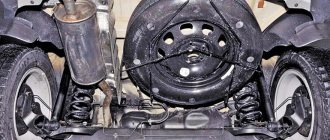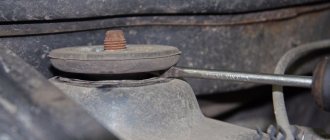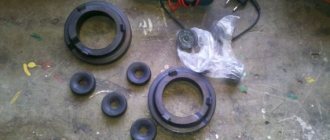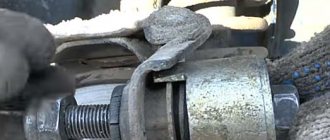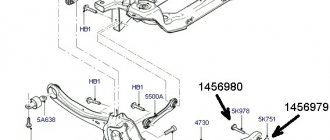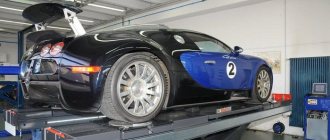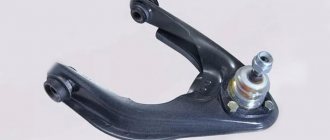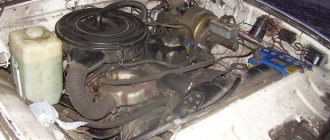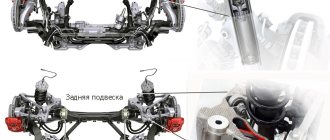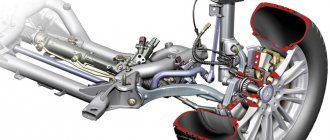In the usual sense, the direction of movement of the car changes when the steering wheel is turned, which transmits force to the front wheels through a simple mechanism, thereby turning them either to the left or to the right. Well, the rear wheels, of course, move exclusively in parallel, but what else? They don't make any turns, do they? Yes, for the most part this is true, as this applies to the vast majority of cars. But some modern cars are equipped with special devices that activate a kind of steering mechanism for the rear wheels. So why was such an innovation invented and on what principle does it work? We will tell you about this and much more later in this material.
Thruster suspension - history of creation
There is no limit to perfection, and therefore today the priority factor in the creation of new automotive systems is improved handling. Although modern existing car control systems perform their functions quite well, restless developers are still competing in the pursuit of creating additional devices that have a positive effect on steering. The currently available and familiar ones include traction control systems and systems.
But even before the full introduction of all kinds of gadgets and microprocessors into vehicle control systems, there were other developments that were technically not so complex, but useful in terms of improving handling. These include the rear wheel steering system.
Examples of ground mobile units with an installed rear axle steering system could be found a hundred years ago. This principle has long been successfully used in forklifts that operate in cramped warehouses, factory workshops and other places. This system was used back in the late thirties on agricultural machinery and SUVs, for example, in the pre-war “rogue” Mercedes Kübelwagen G5.
Types of steering suspension on modern cars
In the first rear wheel steering systems, their rotation angle was impressive and amounted to about 15 degrees. When the speed of vehicles produced began to increase significantly, such large angles had to be cut back. In modern cars, the steering angle reaches a maximum of 8 degrees. Rear steering suspension is divided into two types:
active and passive.
More on this below.
Active
In a vehicle equipped with an active rear wheel steering system, all four wheels turn at once as the driver moves the steering wheel. In modern cars, force is transmitted through the steering wheel not through mechanics - a lever system, but through an ECU command and retractor relays, which are also called actuators. They move the rear tie rods, similar to those used in the main steering system.
The active suspension operates in two steering modes.
For example, when leaving a parking lot or garage, when the front wheels turn in one direction, the rear wheels turn in the opposite direction. Thanks to this, the turning radius is reduced by 20-25%.
At high speeds the operating pattern changes. When turning the front wheels, the rear wheels steer, but at a smaller angle. The angle at which the rear wheels are turned is controlled by an electronic control unit, guided by the readings of the angular acceleration sensor, as well as the speed sensor and others. Based on the readings, an optimal turning algorithm is formed.
The most famous rear suspension steering systems are from Japanese manufacturers.
For example, Honda introduced the rear axle steering option back in 1987 on the Prelude sports coupe. A year later, Mazda introduced this option on its 626 and MX6 models.
The Americans at General Motors also experimented with this system; it was called Quadrasteer. It was optionally installed on Suburban and Yukon SUVs and on the Silverado pickup.
Nissan's steering system was called HICAS. At the beginning of production, it was driven by a hydraulic mechanism and was combined with power steering. It was installed on Nissan and Infiniti models with rear wheel drive. But in the mid-nineties, such a system was abandoned, since it was complex and not highly reliable, and they switched to actuators.
In 2008, Renault-Nissan introduced the Renault Laguna with a new Active Drive rear suspension steering system. The Europeans also did not stand by. For example, BMW has introduced a steering system called Integral Active Steering on the 7 series and 6 series Gran coupe.
Passive
Many modern cars are equipped with a simplified rear wheel steering system. Elements are built into the rear suspension that have certain physical properties that counteract the inertia of linear motion. This type of steering is called passive. In such cars, the rear suspension is designed according to a special geometry using a moving Watt rod.
The system is built in such a way that when you gain sufficient speed and enter a turn, the rear wheels steer in the same direction as the front wheels due to the redistribution of forces in the suspension. In addition to the unusual geometry, the effect is enhanced by installing silent blocks of a certain elasticity and shape. This design has a positive effect on vehicle stabilization when cornering. The first generation Ford Focus was equipped with this system.
In fact, this principle is not some kind of innovative technological solution, since over the past couple of decades engineers have taken into account thruster properties. But some manufacturers, such as Ford, have paid special attention to these properties and separated the design into one special system.
Advantages and disadvantages
And in conclusion, we will discuss the main pros and cons of the steering rear suspension. The positive aspects include increased maneuverability due to a smaller turning radius and improved vehicle handling. The most serious disadvantage is the more complex design of the rear suspension system, which affects the cost of the car and increases repair costs.
Let's be more specific about what power steering is? If you have not yet experienced its effects on your front-wheel drive, then your car does not have very much torque. For this to happen, technical tricks must be applied to solve the problem.
Why is this happening? The main reasons for power steering lie in the technical component of the car. More precisely, due to the asymmetrical angles of the drive shafts of different torque output to each of the shafts in the geometry, deviations in suspension tolerances, unequal traction forces caused by differences in adhesion to the road surface, as well as due to uneven wear of the tires and other differences used in drives, for example in their various diameters.
Thus, such power steering can also manifest itself over time due to worn suspension bushings or tires, and the poor quality of the road surface itself is also negatively affected. The same list can also include engine tuning, which significantly increased it, and many other certain factors.
Over the years, automakers have sought and developed solutions to reduce or eliminate this phenomenon on high-power front-wheel drive models. We, dear readers, will consider today the most progressive methods of combating this phenomenon and explain the technology as well as various technical solutions that are used nowadays by most automakers, which make it possible to make their car models enjoyable to drive.
Drive shafts of equal length.
Since transversely mounted engines usually suffer from power steering, one of the first solutions developed by automakers was to install drives of equal length on the car. To implement this solution, it was necessary to install the engine in a non-standard position, which subsequently led to the effect of understeer.
But nevertheless, with this approach to the issue, there were other innovative solutions. For example, using an intermediate shaft instead of a longer drive shaft that was attached to the gearbox on one side and another shaft of equal and equal length on its other side. Some companies produced and put on sale for the secondary market even longer shafts, which were offered by manufacturers as an option. The results in this case could be very different and only for the worse. Since the manufacturing precision of these tuned shafts had to be very high to ensure reliability and continued safety.
Other solutions included installing a short hollow drive shaft and a solid solid shaft. But not all of these solutions worked, as their performance could be limited in corners, or in the case of high power and high torque.
Revo Knuckle (a specially designed steering knuckle from Ford).
This suspension system was used on the Mk 2. Its development enabled the automaker to provide customers with high-power front-wheel drive hot hatches that did not suffer from loss of control due to the car pulling to the side. Those lucky ones who managed to drive this car will tell you the following: the Mk 2 Ford Focus RS still did not completely get rid of the annoying “bug”; during intense acceleration, the steering wheel still did not behave quite naturally; the suspension was 100% modified and self-locking did not help in solving this problem. However, this impact was minimal.
An interesting fact about the development of the suspension strut was that it was originally designed for the Mondeo range, which suffered the most from power steering in its powerful diesel versions. developed its own suspension system that could handle the additional torque without the need for a limited slip differential. Although, as we have already said, in the Focus RS car, an LSD differential was additionally installed due to even greater torque.
How it works? Let's consider. The ingenious idea was to decouple the steering and suspension functions of the front axle. Ford's solution was to install a "knuckle" on each of the front wheels to provide movement to the steering wheel and separate it from the suspension arms.
Back in the late 1990s, Toyota was the first to produce cars with a similar suspension system, called “Super Struts,” but later systems from “and” became more widespread. A modern car has a similar installation, which was developed specifically by a Japanese automaker. The company calls it Dual Axis Strut Front Suspension and it is used in the front suspension with two kingpins and electronically adjustable shock absorbers.
To improve the performance of the car, a limited slip differential was also installed on it. Engineers estimate that force steering is reduced by about 55% when compared to a conventional suspension.
